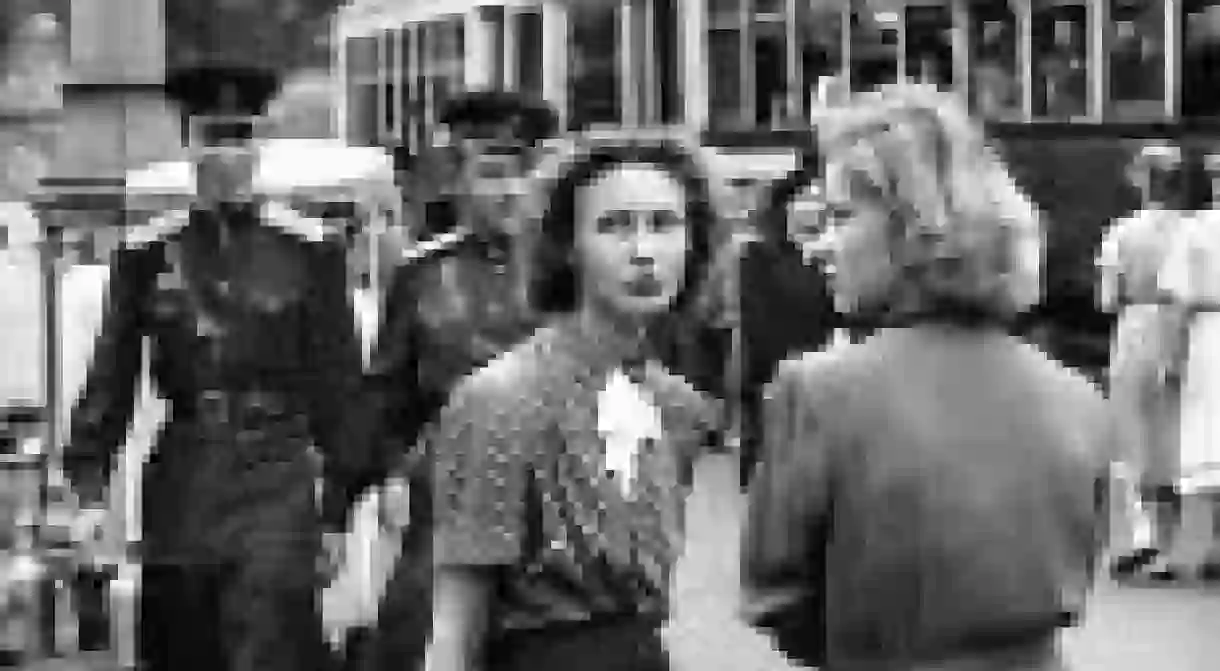The Photography Of Henri Cartier Bresson: Geometry, Intuition, Sensitivity

Through his keen sensibility, understanding of composition, and appreciation for the moment, Henri Cartier-Bresson established his name as one of the greatest photographers of the 20th century. Despite his recognition as such, he did not see himself primarily as a photographer, but as an active participant in the unfolding of history.

In Henri Cartier-Bresson’s iconic photograph, Behind the Gare de Saint-Lazare (1932), a shadowy figure leaps from a ladder lying flat in a valley of water. When Cartier-Bresson recounts this moment, he describes it as an ‘accident.’ While passing a construction site behind the Paris train station, the photographer stuck his lens through the wooden planks of a temporary fence, and without looking through the viewfinder, immortalized the image.
Although this kind of snapshot imagery is now, more or less, the predominant vision of photography, it was revolutionary back in 1932. New technological developments had led to the invention of the Leica camera, fostering the necessary mobility and shutter speed to achieve spontaneity.
A strong opponent of image cropping, Cartier-Bresson was well aware that photography does not allow for rough drafts. Instead, imperfections and discoveries are inherent to the process. In Behind the Gare de Saint-Lazare, the photographer would likely have been delighted with the symmetry created on the surface of the reflective pool and the spontaneity of the jumping subject, repeated in the graphic images of springing acrobats in the circus advertisements affixed to the fence in the background. Cartier- Bresson’s ability to recognize intense life and activity in every context, especially in the gritty, urban environment, is the source of the artist’s genius.

Born in 1908, Cartier-Bresson was raised in a privileged household with his four siblings. He was educated in Paris, where he grew to appreciate the arts. As he entered adulthood he developed a Communist sentiment, which grew into peaceful anarchism – an attitude that he maintained for the entirety of his life. During this time he met early Cubist painter Andre Lhote, and entered his tutelage as a painting student.
Inspired by the exhilarating advancements of the avant-garde movement in Paris, Cartier-Bresson resolved to travel to Africa in 1931 to hunt antelope and boar. Although he eventually grew tired of the sport, it was in Africa where he initially cultivated his passion for photography. The photographer was quoted later in his life as saying, “I adore shooting photography; it’s like being a hunter. But some hunters are vegetarians – which is my relationship to photography.”
By delegating the printing process to others, Cartier-Bresson was free to spend more time photographing. He saw himself as an onlooker, describing the process of taking a photograph as intensely focused. He was keenly aware of the advantage that training as a painter had had on his photographic career through the careful ability it awarded him to recognise an interesting composition. Above all else the artist identifies geometry, intuition and sensitivity as the key factors in creating an extraordinary image.
Geometry relates to the structure and balance of forms within a scene. This interrelationship between forms is almost always impermanent, and thus great intuition and sensitivity are required to frame and seize the arrangement at a precise moment. Cartier-Bresson believed that an individual was either born with the ability to comprehend these three factors in unison or they were not; it was not something that could be taught.

The photographer’s rise to success was rapid. By the mid 1930s he was exhibiting internationally amidst the public’s positive response to his ingenious exploration into the possibilities of street photography and photojournalism. In 1947, together with Robert Capa, George Rodger, David ‘Chim’ Seymour, and William Vandivert, he founded Magnum Photos to celebrate the work of international photojournalists. The photo agency has since become one of the leading image organizations in the world.
Along with his photographic investigation into the shadier aspect of the urban realm, Cartier-Bresson used friends and the cultural elite as subjects. He chased the significant events of the 20th century, travelling extensively to Asia to revel in the revolutionary spirit of India in the 1940s. A short time prior to his assassination in 1948, Cartier-Bresson photographed Mohandas Gandhi. Following the Mahatma’s death, the photographer made an extensive series to document the impact that Gandhi had had on this nation on the verge of change, a photographic essay which would become one of Life Magazine’s most celebrated features. The Spanish Civil War, the Chinese Revolution, the crowning of King George VI and Krushchev’s post Stalin premiership in Russia are among the other world altering events that this master of photojournalism chased down through his keen ability to recognize the momentous occasion.
In filmed interviews done later in the photographer’s life, Cartier-Bresson’s blunt responses to queries into his past as a photographer suggest a removal from this high speed period of his career. In 1966, the photographer quit Magnum and stopped taking pictures, returning instead to drawing and painting, a far more meditative creative process. In 2004 at nearly 96, this 20th century icon passed away at his home in Provence. The year prior, following his acceptance of abundant awards and honors, Cartier Bresson and his family opened the Fondation Henri Cartier-Bresson in Paris, France, preserving the legacy of this pioneer of modern photography.













